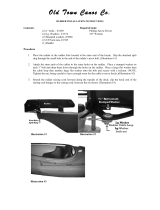
Install Tubing
1. Use a knife to cut the ends of the tubing at an angle to make inserting the tubing easier. Lubricate one length of tubing with
soapy water and insert it into a stern grommet (5). Push the tubing inside the kayak, leaving a few inches outside.
2. Reach inside the 6-inch hatch to get the tubing. Push the tubing (inside the kayak) through the bow grommet (4). Hold your
fingers over the grommet as you pull the tubing out, to make sure the grommet stays in place. Make sure the tubing is routed
outside the scupper holes along the inside of the kayak.
3. Repeat this process on the other side of the kayak, moving from point 6 to point 3.
NOTE: If you have a 2-hatch Pro, open the stern hatch to help you push the tubing inside the kayak. If you have a Pro with tank
well, cut a small hole in one end of the tubing and insert a wire. Use the wire to help pull the tubing from the stern grommet to the
bow grommet. (Tip the kayak on the side you are working so the tubing will pass outside the scupper hole.) Use the adhesive-
backed strap eyes to keep the tubing off to the sides within the stern hatch of the 2-hatch Pro.
Install Steering Lines
1. Straighten each steering line and trim frayed ends. Insert a steering line into the tubing at the rear of the kayak and push it
through to the other end of the tubing. If the line bunches, pull it out, straighten it, and re-insert it. Do this on both sides of the kayak.
Install Steering Tracks
1. Place a steering track above the ledge at the top of the foot wells (1), lining it up so the front of the track is even with the front
edge of the last foot well, and the upper edge of the track is even with the upper edge of the kayak. (The track must be high enough
so it does not get caught on the foot wells.) Make sure the drainage slot on the slide is facing down.
2. While you hold the track in place and the slide out of the way, mark the holes on the steering track to use as a guide for the drill.
3. Using the markings as a guide, drill 3/8” holes into the kayak. Insert a well nut into each hole (2 on each side).
4. Place the steering track over the well nuts and match up the holes. Thread a large machine screw through the track and into
each well nut (not too tight). Make sure the heads of the screws are in far enough to allow the steering slide to move freely.
5. Repeat this process on the other side of the kayak.
Attach Steering Pedals to Steering Slides (if they are not already installed)
1. Remove the tape from the steering tracks and slides.
2. Attach the steering pedals to the steering slides by squeezing the lever on each steering pedal while sliding it into the end of the
steering slide.
Tie Steering Line to Steering Slides
1. Sit in the kayak and adjust the position of the steering pedals with the pedal lever so you can push both pedals with your feet
comfortably.
2. Center the steering slide in the steering track and temporarily hold in place with duct tape. (This will keep the slides secure
when you attach steering lines to the rudder.)
3. Tie a bowline knot in the front of each steering line. Begin to thread a short machine screw into the hole at the back of steering
slide. Before threading too far, hook the loop of the knot over the head of the screw. Continue threading the screw until the head
comes in contact with the sides of the steering slide.








